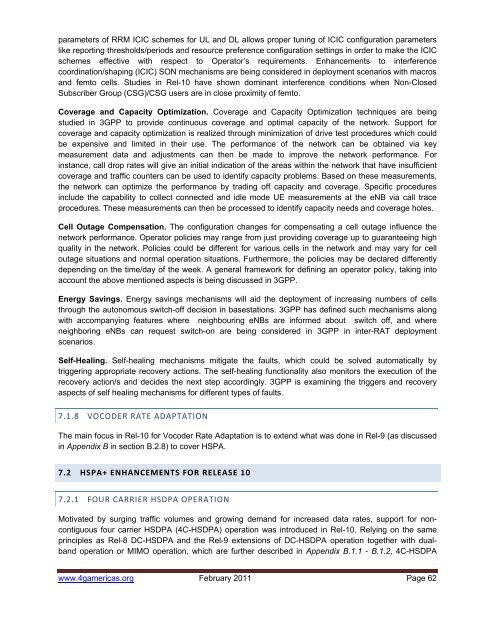You also want an ePaper? Increase the reach of your titles
YUMPU automatically turns print PDFs into web optimized ePapers that Google loves.
parameters of RRM ICIC schemes for UL and <strong>DL</strong> allows proper tuning of ICIC configuration parameters<br />
like reporting thresholds/periods and resource preference configuration settings in order to make the ICIC<br />
schemes effective with respect to Operator’s requirements. Enhancements to interference<br />
coordination/shaping (ICIC) SON mechanisms are being considered in deployment scenarios with macros<br />
and femto cells. Studies in Rel-10 have shown dominant interference conditions when Non-Closed<br />
Subscriber Group (CSG)/CSG users are in close proximity of femto.<br />
Coverage and Capacity Optimization. Coverage and Capacity Optimization techniques are being<br />
studied in 3GPP to provide continuous coverage and optimal capacity of the network. Support for<br />
coverage and capacity optimization is realized through minimization of drive test procedures which could<br />
be expensive and limited in their use. The performance of the network can be obtained via key<br />
measurement data and adjustments can then be made to improve the network performance. For<br />
instance, call drop rates will give an initial indication of the areas within the network that have insufficient<br />
coverage and traffic counters can be used to identify capacity problems. Based on these measurements,<br />
the network can optimize the performance by trading off capacity and coverage. Specific procedures<br />
include the capability to collect connected and idle mode UE measurements at the eNB via call trace<br />
procedures. These measurements can then be processed to identify capacity needs and coverage holes.<br />
Cell Outage Compensation. The configuration changes for compensating a cell outage influence the<br />
network performance. Operator policies may range from just providing coverage up to guaranteeing high<br />
quality in the network. Policies could be different for various cells in the network and may vary for cell<br />
outage situations and normal operation situations. Furthermore, the policies may be declared differently<br />
depending on the time/day of the week. A general framework for defining an operator policy, taking into<br />
account the above mentioned aspects is being discussed in 3GPP.<br />
Energy Savings. Energy savings mechanisms will aid the deployment of increasing numbers of cells<br />
through the autonomous switch-off decision in basestations. 3GPP has defined such mechanisms along<br />
with accompanying features where neighbouring eNBs are informed about switch off, and where<br />
neighboring eNBs can request switch-on are being considered in 3GPP in inter-RAT deployment<br />
scenarios.<br />
Self-Healing. Self-healing mechanisms mitigate the faults, which could be solved automatically by<br />
triggering appropriate recovery actions. The self-healing functionality also monitors the execution of the<br />
recovery action/s and decides the next step accordingly. 3GPP is examining the triggers and recovery<br />
aspects of self healing mechanisms for different types of faults.<br />
7.1.8 VOCODER RATE ADAPTATION<br />
The main focus in Rel-10 for Vocoder Rate Adaptation is to extend what was done in Rel-9 (as discussed<br />
in Appendix B in section B.2.8) to cover HSPA.<br />
7.2 HSPA+ ENHANCEMENTS FOR RELEASE 10<br />
7.2.1 FOUR CARRIER HSDPA OPERATION<br />
Motivated by surging traffic volumes and growing demand for increased data rates, support for noncontiguous<br />
four carrier HSDPA (4C-HSDPA) operation was introduced in Rel-10. Relying on the same<br />
principles as Rel-8 DC-HSDPA and the Rel-9 extensions of DC-HSDPA operation together with dualband<br />
operation or MIMO operation, which are further described in Appendix B.1.1 - B.1.2, 4C-HSDPA<br />
www.4gamericas.org February 2011 Page 62

















